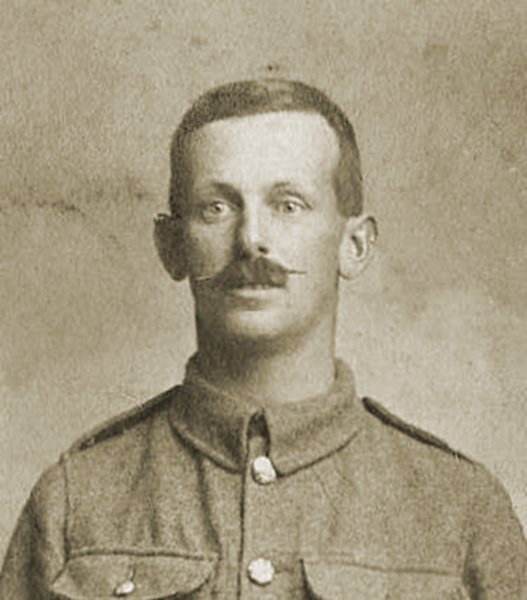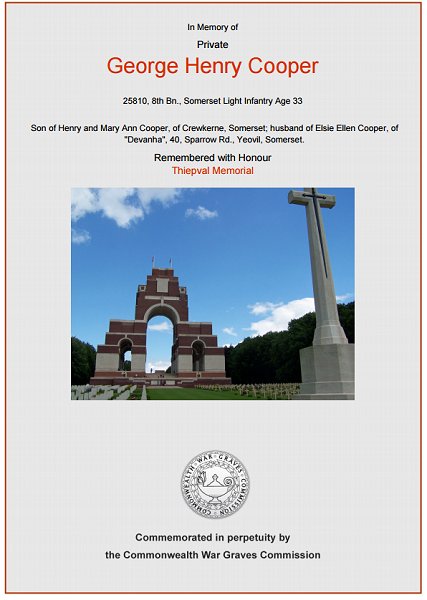yeovil at War
George Henry Cooper
Killed in action during the Battle of the Ancre
George Henry Cooper was born in Crewkerne, Somerset, on 19 April 1884, the eldest child of shirt cutter Henry Cooper (1858-1924) and Mary Anne née Hallett (b1860), both of Crewkerne. In the 1891 census Henry and Mary were living in Lye Water, Crewkerne, with their children; George, John (1884-1968), Daisy E (b1887) and Mary's mother, Ann Hallett. The family were at the same address in the following census of 1901 and at this time 17-year old George gave his occupation as a postman.
In the autumn of 1906 George married Elsie Ellen Gooding at Yeovil. They were to set up home at 25 King Street, Yeovil, where they were recorded in the 1911 census. George still worked as a postman. They later lived at 'Devanha', 40 Sparrow Road, Yeovil.
 Although
it is not known
when George
enlisted, he
enlisted in
Yeovil joining
8th (Service)
Battalion,
Somerset Light
Infantry. His
Service Number,
235810,
suggesting he
enlisted during
1915.
Although
it is not known
when George
enlisted, he
enlisted in
Yeovil joining
8th (Service)
Battalion,
Somerset Light
Infantry. His
Service Number,
235810,
suggesting he
enlisted during
1915.
The 8th (Service) Battalion was formed at Taunton on 20 October 1914 and came under command of 63rd Brigade, 21st Division. The battalion went to France on 10 September 1915, landing at Le Havre.
On 25 September 1915, the 6th, 7th and 8th Battalions of the Somersets became embroiled in the Battle of Loos - the British Army's contribution to the major Allied offensive launched simultaneously with the main French offensive in Champagne. It was the biggest British attack of 1915.
A continuous preliminary bombardment, which showered 250,000 shells on to the German defences over four days, had little real effect. Before sending in the infantry on the morning of 25 September 1915, the British released 140 tons of chlorine gas from 5,000 cylinders placed on the front line to make up for the ineffective artillery barrage. This was the first time the Allies had used the weapon, coming after the Germans employed gas to terrible effect at Ypres in April earlier in the year, and it was hoped it would annihilate the Germans at Loos. However a change in the direction of the wind at several points along the front blew the gas back into the British trenches, causing seven deaths and injuring 2,600 soldiers who had to be withdrawn from the front line. Initially the gas attack created panic among the Germans and close to 600 men were gassed. Despite the setbacks caused by the wind 75,000 British infantrymen still flowed out from the trenches when the order came. British losses at Loos were exceptionally high with 50,000 casualties, including at least 20,000 deaths.
During the
Battle of Loos,
the 21st
Division
suffered over
3,800 casualties
and took the
rest of the year
to rebuild.
From July to
November 1916
the battalion
took part in the
Battles of the
Somme. On 8 July
1916 the
battalion
transferred with
63rd Brigade to
37th Division.
The battalion
next fought in
the Battle of
the Ancre from
13 to 18
November 1916.
This was the
final large
British attack
of the Battle of
the Somme in
1916. It
involved an
attack on the
German front
line as it
crossed the
Ancre River, a
sector of the
front that had
first been
attacked on the
first day of the
Battle of the
Somme without
success. This
was a strong
sector of the
German front.
The first
British
objective
involved an
advance of 800
yards and would
require the
capture of at
least three
lines of
trenches. The
next target was
the German
second line,
from Serre south
to the Ancre.
Finally it was
hoped to capture
Beaucourt, on
the Ancre. All
the early
successes on the
Ancre achieved
was the creation
of a British
held salient on
the Ancre, which
proved to be a
very dangerous
area to be
posted over the
winter of
1916-17. George
was killed in
action on 19
November 1916,
he was aged 33.
George Cooper is commemorated on the Pier and Face 2A of the Thiepval Memorial, Somme, France, and his name is recorded on the War Memorial in the Borough.
gallery

George Henry Cooper, photographed around 1915.

The Commonwealth War Graves Commission certificate in memory of George Cooper.